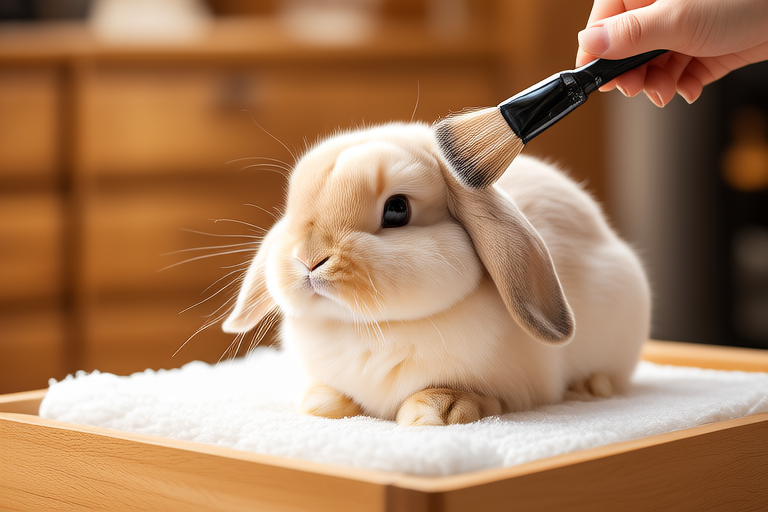How to Groom and Keep Your Lop Rabbit Happy and Healthy
Welcome to this comprehensive guide on grooming and maintaining the health and happiness of your lop rabbit. Whether you’re a first-time owner or an experienced one, this article will provide you with all the essential information you need to ensure your furry friend lives a long, happy, and healthy life.
Essential Grooming Techniques
Grooming your lop rabbit is more than just keeping them clean; it’s about maintaining their health and well-being. Here are some essential grooming techniques:
- Bathing: While rabbits are generally clean animals and rarely need baths, they may require one if they get excessively dirty or have a medical condition. Use a gentle, unscented shampoo and warm water, ensuring to rinse thoroughly to avoid skin irritation.
- Brushing: Regular brushing helps remove loose fur and prevents matting. Choose a soft-bristled brush suitable for your rabbit’s coat type.
- Nail Trimming: Overgrown nails can cause discomfort and affect your rabbit’s mobility. Trim them regularly, taking care not to cut the quick (the blood vessel inside the nail).
- Tooth Care: Rabbits’ teeth grow continuously, so providing hay and chew toys helps wear them down naturally. However, regular dental check-ups are crucial to prevent overgrowth.
Necessary Tools
Having the right tools makes grooming easier and more effective. Here’s what you’ll need:
- Soft-bristled brush or comb
- Blunt-nosed scissors
- Trimming clippers
- Lint roller
- Styptic powder (in case of accidental cuts)
- Eye wash solution
- Ear cleaner
- Soft cloth
Frequency of Grooming
The frequency of grooming depends on several factors, including your rabbit’s age, breed, and living environment. As a general guideline:
- Brushing: Once or twice a week, depending on the season and coat type.
- Bathing: Only when necessary, as frequent bathing can strip natural oils from the skin.
- Nail Trimming: Every few weeks, checking for signs of overgrowth.
- Tooth Care: Daily observation and regular veterinary check-ups.
Signs of a Healthy Rabbit
Knowing what constitutes good health in your lop rabbit is vital. Here are some indicators:
- Energetic and active behavior
- Healthy appetite and weight
- Clear eyes, nose, and ears
- Smooth, shiny coat
- No discharge from any openings
- No visible lumps or bumps
- Regular, formed droppings
Dietary Tips
A balanced diet is crucial for your rabbit’s health. Here are some dietary tips:
- Hay: Unlimited access to high-quality hay, such as timothy or orchard grass, promotes digestive health.
- Vegetables: Offer a variety of fresh vegetables daily, avoiding those high in calcium or oxalates.
- Fruits: Occasional treats, but in moderation due to their sugar content.
- Pellets: High-fiber pellets formulated for adult rabbits.
- Water: Fresh, clean water available at all times.
Exercise Recommendations
Rabbits need ample space to move around and play. Here are some exercise recommendations:
- Living Space: A spacious cage with multiple levels and hiding spots.
- Playtime: Supervised time outside the cage in a safe, enclosed area.
- Toys: Chew toys, tunnels, and balls to stimulate mental and physical activity.
- Outdoor Time: Limited outdoor time during favorable weather conditions, ensuring protection from predators.
Common Health Issues
While lop rabbits are generally hardy, they are prone to certain health issues. Being aware of these can help you address them promptly:
- Dental Problems: Overgrown teeth can lead to pain and difficulty eating. Regular dental checks are essential.
- Gastrointestinal Stasis: A serious condition where the digestive system slows down or stops. Signs include reduced appetite and lethargy.
- Hutch Sores: Skin infections caused by prolonged contact with wet bedding. Keeping the living area clean and dry is crucial.
- Mites: Parasitic infestations that cause itching and hair loss. Consult a veterinarian for treatment options.
- Urinary Tract Infections: Common in older rabbits. Watch for changes in urination habits or the appearance of blood in urine.
How Regular Grooming Contributes to Their Overall Well-being
Regular grooming isn’t just about aesthetics; it plays a significant role in your rabbit’s overall health and happiness. Here’s why:
- Promotes Good Hygiene: Keeps your rabbit clean and free from dirt, debris, and parasites.
- Enhances Bonding: Spending quality time together strengthens your bond and reduces stress.
- Early Detection of Health Issues: Frequent grooming allows you to notice early signs of illness or injury.
- Maintains Coat Health: Prevents matting and tangling, reducing the risk of skin irritations.
- Supports Dental Health: Providing appropriate chew toys helps maintain healthy teeth and gums.
Practical Advice for New Owners
If you’re new to rabbit ownership, here are some practical tips:
- Research extensively before bringing your rabbit home.
- Prepare the living space well in advance.
- Choose high-quality food and supplies.
- Consult with a veterinarian experienced with rabbits.
- Be patient and consistent with training and bonding.
Useful Tips for Experienced Owners
Even experienced owners can benefit from these tips:
- Stay updated on the latest care practices and advancements.
- Join local rabbit clubs or online communities for support and advice.
- Rotate toys and activities to keep your rabbit mentally stimulated.
- Consider adopting another rabbit for companionship.
- Regularly review your rabbit’s living environment for improvements.
In conclusion, grooming and caring for your lop rabbit is a rewarding experience that strengthens your bond and ensures their well-being. By following the guidelines outlined in this article, you’ll be well-equipped to provide your furry friend with a happy, healthy life. Remember, every rabbit is unique, so tailor your care routine to suit their individual needs.
